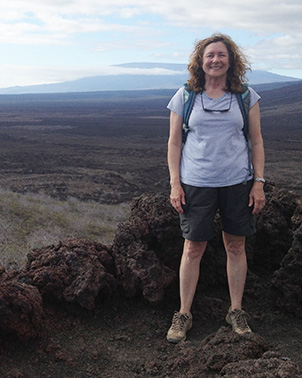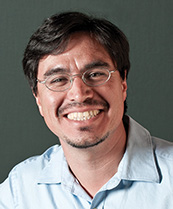This is an unprecedented and extraordinary time. The fabric of our personal and professional lives is changing daily, and it will be different as you read this message than it was when I wrote it a few weeks ago. Now more than ever, we should value our ASPB community. Indeed, none of us is alone, as my picture suggests.
 The goals of this letter are to point you toward resources that might be particularly helpful to the ASPB community and to encourage all of us to reach out (virtually, of course) to our colleagues to offer support and to provide (or seek) assistance when needed. To academics in particular, if you are knowledgeable about distance or online instruction and assessment or have teaching modules that are sharable, consider making them available via Plantae. The resources on Plantae support professionals and students worldwide without charge and provide communities with a forum for discussion and resource sharing. Join Twitter if you haven’t already and follow ASBP (@ASPB); post ideas, ask for suggestions, and list resource URLs. Better yet, encourage your colleagues (and help them) to join Twitter and follow ASBP to keep us connected.
The goals of this letter are to point you toward resources that might be particularly helpful to the ASPB community and to encourage all of us to reach out (virtually, of course) to our colleagues to offer support and to provide (or seek) assistance when needed. To academics in particular, if you are knowledgeable about distance or online instruction and assessment or have teaching modules that are sharable, consider making them available via Plantae. The resources on Plantae support professionals and students worldwide without charge and provide communities with a forum for discussion and resource sharing. Join Twitter if you haven’t already and follow ASBP (@ASPB); post ideas, ask for suggestions, and list resource URLs. Better yet, encourage your colleagues (and help them) to join Twitter and follow ASBP to keep us connected.
Fortunately for educators, ASPB already has developed some potent online resources. Teaching Tools in Plant Biology, first developed by Mary Williams, a features editor for The Plant Cell, is a free resource with more than 40 tools available. If you haven’t perused the topics recently, I urge you do so; the recent addition “Computational Image Processing in Microscopy” includes a hands-on workshop. Another free resource is the online image library from the first edition of Biochemistry & Molecular Biology of Plants. And Focus Collections in Plant Physiology (35 of them) are excellent resources for a themed course.
Mentoring is valued at ASPB and is particularly important in these stressful times. Again, ASPB can help as you remind mentees of the value of your professional community. A student space on Plantae features resources and discussions for undergraduate and graduate students. And in lieu of in-person meetings, webinars are already available, spanning topics from professional development (e.g., Preparing Your Manuscript for Submission) to sharing experiences (Social Media for Scientists: What, Why, and How; We Are Here and We Are Scientists! LGBTQ+ Perspectives and Topics in Plant Science) to expanding technical expertise (Transdisciplinary Plant Phenomics and Phenotyping for Maize Crop Improvement). These and many other webinars are available for viewing on Plantae (https://plantae.org/education/plantae-webinars/), and ASPB is adding more every month. Keep checking the site (as well as Twitter and your email!) for announcements of future webinars in which you may participate live and ask questions of the panelists.
Finally, as part of our ongoing Transparency Project, standing committees are highlighted through these letters. The Membership Committee (for current members, see https://aspb.org/about/committees/#toggle-id-7) is guided by its new chair, José Dinneny, and supported by Shoshana Kronfeld, ASPB’s senior membership manager. To get to know José, I asked him a few questions. When you see him, Shoshana, or Membership Committee members, please thank them for their efforts.
For updates on ASPB and COVID-19, please visit https://aspb.org/covid-19/. Stay safe and healthy.
Meet José Dinneny, Membership Committee Chair
 To help members get to know you, how did you get into plant science?
To help members get to know you, how did you get into plant science?
It really began as I was trying to choose my major at the University of California, Berkeley. I had become a bit disillusioned by the large number of premed students in the molecular and cellular biology major and did not feel they shared my passion for discovery. I was excited about how basic discovery could ultimately be applied to increase the sustainability of our society and started to think more about majoring in plant biology. When I looked at the courses required, I was excited by the holistic education in plants I would get. Donald Kaplan’s Plant Morphology course got me hooked on development, and Sarah Hake and Robert Fischer’s Plant Development course ultimately led me to join Detlef Weigel’s lab at the Salk Institute for Biological Studies.
What do you value about your ASPB membership?
I love the big-tent feeling of ASPB. You have members from all walks of careers and disciplines. The young plant scientists also have an important role to play in the governance of the Society and in bringing innovative new ideas. With the recent initiation of the Early Career Plant Scientists Section, I hope we will see even more participation by students and postdocs in ASPB.
Thank you for your service as chair of the Membership Committee. As you begin your leadership, is there anything in particular you would like your committee to focus on?
We need to help our young plant scientists see the value of joining and maintaining their membership in ASPB. This Society really works for them by supporting plant science funding, outreach, and training. The best way for young scientists to make sure ASPB is doing these things well is to actively participate in the Society and act as on-the-ground ambassadors communicating the importance of plant science.
What is your favorite activity at the annual Plant Biology meeting?
If I’m to be 100% honest, it’s presenting my lab’s research. It’s ultimately important for us to understand that at our core, we are a scientific society here to support the success of plant scientists. ASPB meetings are great because of the many opportunities students and postdocs have to present their research, discuss their ideas, make professional connections, and raise the game of their research. This is true for trainees but also for more established scientists.
